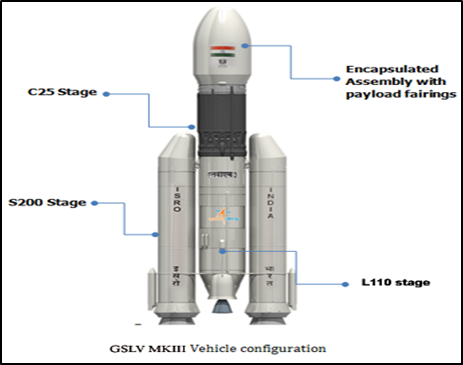In News:
- The Indian Space Research Organization's (ISRO) heaviest rocket - the GSLV MKIII, will launch 36 satellites of the OneWeb communication constellation from the country's only space port in Sriharikota, Andhra Pradesh, soon.
- With this launch, the GSLV MKIII will enter the global commercial launch service market.
What’s in today’s article:
Geosynchronous Satellite Launch Vehicle (GSLV):
- It is a space launch vehicle designed, developed and operated by the ISRO to launch satellites and other space objects into Geosynchronous Transfer Orbits (GTO).
- A satellite in the GTO, orbits (at an altitude of ~37,000 km) the Earth once per day, keeping the satellite in roughly the same area over the ground.
- GSLV has the capability to put a heavier payload (up to 5,000 kg up to 37,000 km) in orbit than the Polar Satellite Launch Vehicle (PSLV can carry up to 2000 kg into space up to 600-900 km).
- PSLV is designed mainly to deliver earth observation or remote sensing satellites, whereas GSLV has been designed for launching communication satellites.
- GSLV delivers satellites into a higher elliptical orbit - GTO.
- GSLV is a 3-stage launcher with strap-on motors.
- The first stage - uses the solid rocket motor with four liquid engine strap-on motors. This stage generates maximum thrust.
- The second stage uses a liquid rocket engine which is known as Vikas engine.
- The third stage uses a Cryogenic engine, which uses liquefied oxygen and hydrogen as fuel.
- GSLV-D5 - launched in 2014 - was the first successful flight of the GSLV using the indigenous cryogenic engine (CE-7.5).
About GSLV MKIII:

- GSLV MKIII Project was approved in 2002, with a mandate of achieving the capability to launch a 4-ton (4000 kg) class satellite to Geo-Synchronous orbit, by realizing an indigenously developed launch vehicle.
- GSLV MKIII is configured as a 3-stage vehicle with two solid strap-on motors (S200, among the largest in the world), one liquid core stage and a high thrust Cryogenic Upper Stage (CUS).
- Characteristics of GSLV MKIII:
- Performance capability of 4.3 ton to GTO
- Payload capability to support 10 ton to LEO missions
- Cost effective
- Improved reliability, operability and redundancy management
- Future growth potential of payload with minimal design changes
- To support manned missions (like Gaganyaan mission) of Indian Space Programme
- The maiden operational flight of GSLV MKIII has successfully launched Chandrayaan-2 spacecraft into the Super Geo-Synchronous Transfer Orbit in 2019.
News Summary:
- Earlier, NewSpace India Limited (NSIL) - a central public sector enterprise (CPSE) under the Department of Space and the commercial arm of the ISRO, has signed two launch service contracts with M/s OneWeb, United Kingdom.
- OneWeb is a global communications network, powered from space, enabling connectivity for governments, businesses, and communities.
- Bharti group-backed OneWeb is implementing a constellation of LEO satellites.
- As part of the contract, 36 communication satellites will be placed into orbit by one LVM3 - ISRO’s heaviest launcher, from Satish Dhawan Space Centre, under the OneWeb India-1 Mission.
- It will be the first LVM3 dedicated commercial launch and through this launch LVM3 is making its entry into the Global commercial launch service market.
- This will be the second flight of the GSLV MKIII, since it carried India’s second lunar mission Chandrayaan-2.
- Also, this will be the first time a rocket other than India’s workhorse - PSLV, is being used to carry out a commercial launch.
- Since its first operational flight, the PSLV has launched at least 345 foreign satellites from 36 countries (PSLV-C37 - the most notable, that put 104 satellites (of which 101 were foreign commercial satellites) in orbits in 2017).
- India currently has three operational launch vehicles - the PSLV, GSLV and GSLV Mk III.
- In 2020, the government opened the space sector to the private sector with the goal of allowing private players to provide routine space services while ISRO focuses on scientific missions.










